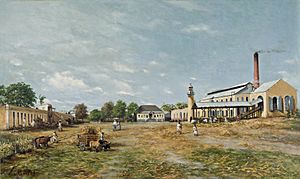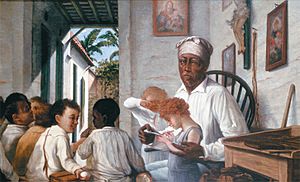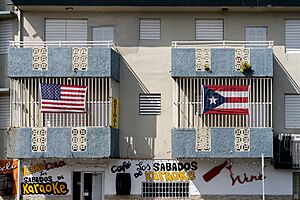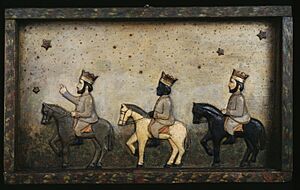Culture of Puerto Rico facts for kids
The culture of Puerto Rico is a mix of many different influences from the past and present. It shows off the island's rich history and helps create a special identity. This unique Puerto Rican identity comes from the Taíno (Native American people), Spanish, African, and North American cultures.
Contents
Influences on Puerto Rican Culture
The Taíno People
The Taíno were a group of Native Americans who lived in the Caribbean, including Puerto Rico. When Juan Ponce de León arrived, there were about twenty Taíno villages, called yucayeque. These villages could have had from single families to groups of 3,000 people.
The Spanish wanted the Taíno to accept the King of Spain as their ruler. They also expected them to pay tribute with gold, work, provide food, and follow Christian customs. The Taíno fought back, especially in 1511. Several Taíno leaders (called caciques) planned to remove the Spanish. Even their traditional enemies, the Caribs, joined them. However, the Taíno weapons were no match for Spanish horses and firearms. Governor Juan Ponce de León's forces quickly and brutally ended the revolt.
Because of this, much of the Taíno culture, language, and traditions were lost. Some even said they "vanished" 50 years after Christopher Columbus arrived. But since the early 2000s, people have been working to bring back and rebuild Taíno culture.
The Taíno people greatly influenced the daily life and language that developed during Spanish rule. Many towns in Puerto Rico still use Taíno names, like Utuado, Mayagüez, Caguas, and Humacao.
Europeans also copied many Taíno tools and methods. These include the bohio (a straw hut) and the hamaca (hammock). The musical instrument called maracas and the way to make cassava bread also came from the Taíno. Many Taíno words are still part of the Puerto Rican language today. These include names of plants, trees, and fruits like maní, yuca, and mamey. Names of animals like iguana and manati are also Taíno. Other words like güiro (a musical instrument), canoa (canoe), and barbacoa (barbecue) also come from the Taíno. Some Taíno words even made it into English, like huracan (hurricane) and hamaca (hammock). Many Taíno stories and beliefs were also adopted by the Spanish. They still influence Puerto Rican imagination.
European Influences

Spain, which colonized the island, had the biggest European influence. There are also smaller influences from Italy and other countries. Spanish heritage has left a lasting mark on the island. You can see signs of this cultural exchange everywhere. This includes the old Colonial buildings, the official language (Spanish), and the island's books and local food styles. As early as the 1500s, the Spanish built huge defense structures. These protected Old San Juan and its bay from other invaders. Parts of Old San Juan and La Fortaleza are now UNESCO World Heritage Sites.
European culture also shaped the performing arts in Puerto Rico, especially music. Many of the island's music styles come from Spanish culture. These include decima, seis, danza, and mambo.
Cockfighting is a sport that has been part of Puerto Rican culture for centuries. In 1845, Manuel Alonso wrote in his book El Gíbaro that a neighborhood might not have a church, but it would always have a cockfighting place. This sport was passed down through families. There are 71 official venues, and many people attend events each year. In December 2019, cockfighting became illegal again in Puerto Rico. However, Governor Wanda Vázquez Garced asked for a delay. She said the industry brings in $9 million each year and many people would lose their jobs.
African Influences
When slavery was brought to the colony, many Africans arrived. They brought their own cultural influences from their tribes. These influences are clear in dance and music. Examples include bomba, plena, and more recently, reggaeton. Reggaeton is an Afro-Caribbean based Puerto Rican music style. African influences also appear in Puerto Rican Spanish and Puerto Rican food.
African religions, like Santeria, are present due to African influence. There are also more subtle connections. For example, Puerto Rico's literary history is linked to the rich African tradition of oral storytelling. Also, all Afro-Caribbean, Afro-Latino, and African American cultural influences from the United States, nearby Caribbean islands, and Puerto Rico itself, largely come from Africa.
Caribbean and Latin American Influences
Many Caribbean nations share African heritage. This is seen in cultural activities like dance and local food. Most regional influences are Latino and Afro-Caribbean. The nearby islands most influenced by Puerto Rico's dance and music are Cuba, the Dominican Republic, and Jamaica. Panama helped create exciting Spanish Reggae with its roots in Puerto Rico. This was the Spanish version of Jamaican Reggae. Later, reggaeton, a Puerto Rican style that came from Spanish reggae, became very popular across Latin America, the Caribbean, the US, and Spain.
Puerto Rican artists helped create Salsa music with Cuban artists. They also helped Dominican artists develop Merengue. Recent immigration from Haiti and the Dominican Republic has brought many new cultural influences. There has been a lot of cultural exchange between Puerto Rico and the US Virgin Islands. This is especially true for St. Croix, Vieques, and Culebra. An example is Puerto Rican style Patois mixed with Spanish.
Several Latin American countries have also influenced Puerto Rico's culture. In filmmaking, co-productions between Puerto Rico and other Latin American countries have led to shared ideas. This has influenced their film styles. For instance, the Latin sense of humor and magical elements are clear in Puerto Rican films.
United States Influences


Culturally, Puerto Ricans sometimes copy the U.S. and sometimes oppose it. This is because of the complex relationship between the two. Since Puerto Rico became an unincorporated territory of the United States in 1898, its traditional economy, social structure, national pride, and culture have been affected by this relationship.
Before the United States took Puerto Rico from Spain in 1898, the colony was based on farming. Most people worked on sugar cane, tobacco, or coffee farms. Through the early 1900s, Puerto Ricans remained farmers. "Operation Bootstrap" began in 1942. This was a plan by the United States and the Puerto Rico Economic Development Administration. Its goal was to change Puerto Rico into an industrial colony. Government-owned factories were built to shift development to factory work. Eventually, this also included educating the factory workers.
One effect of Puerto Rico's industrial growth was a change in family structure. The United States' idea of small, patriarchal families also influenced Puerto Rican family policies. To try and end poverty in shantytowns, the Puerto Rico Housing Authority built public housing. This followed United States policy. Public housing further separated large multi-generational families. It divided nuclear families into public, single-family homes. Connections to extended family are still important in Puerto Rican family culture, but they have become weaker.
The relationship between the United States and Puerto Rico makes national identity complex. Puerto Ricans are United States citizens, but they also strongly identify with their unique Puerto Rican heritage. Even though the island's culture is not all the same, Puerto Rico often contrasts itself with the United States. This includes American identity versus Puerto Rican identity, English language versus Spanish language, Protestant versus Catholic, and British heritage versus Hispanic heritage.
Cultural Pursuits
- Architecture of Puerto Rico – The island has a World Heritage Site. It also has many famous buildings from the Pre-Columbian time to modernist architecture by Jose Firpi, Jonathan Marvel, and Segundo Cardona.
- Art in Puerto Rico – Puerto Ricans have made great contributions to visual arts. This includes major museums, individual artists, and art groups.
- Cinema of Puerto Rico – The island has its own film industry. It also plays a role in international movies.
- Cuisine of Puerto Rico – Puerto Rican food is becoming more famous outside the island. It features traditional and fusion dishes.
- Puerto Rican literature – Poets, novelists, and playwrights like Julia de Burgos, Giannina Braschi, and Lin-Manual Miranda have helped Puerto Rico gain international fame.
- Music of Puerto Rico – Music on the island mixes many different cultural influences. Performing arts like dance are a key part of cultural expression.
- Puerto Rican poetry – Written in Spanish, Spanglish, or English, Puerto Rican poetry has greatly contributed to Nuyorican, American, and slam poetry. It has also inspired many songwriters.
- Puerto Rican comic books
- Sports in Puerto Rico
See also
 In Spanish: Cultura de Puerto Rico para niños
In Spanish: Cultura de Puerto Rico para niños





